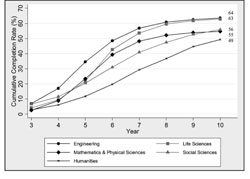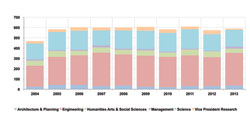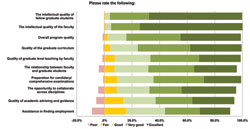
| Vol.
XXVI No.
2 November / December 2013 |
| contents |
| Printable Version |
Doctoral Education Outcomes and Impact
Doctoral education at MIT dates back 100 years, is central to the mission of MIT and vital to maintaining competitiveness and leadership as a world-class research university. MIT currently has a doctoral population of the 3843 currently enrolled doctoral students, of whom 42% are international, 31% are female, and ~11% are underrepresented minority (of U.S. citizen and permanent resident) (Source: Office of the Provost/Institutional Research). Doctoral education at MIT maintains elements of the classical apprentice model including a core of high quality thesis research, as well as, often, formal coursework and the immersion of students in a rich environment of co-curricular learning opportunities (e.g., international experience, entrepreneurship, public service, etc.).
A number of recent national and international reports have questioned the effectiveness of the current state of doctoral education and called for its reform to better prepare graduate students who are more often pursuing a diversity of career pathways outside of academia (see: Research Universities and the Future of America, National Academies of Sciences, 2012; Education for Life and Work: Developing Transferable Knowledge and Skills in the 21st Century, National Academies of Science, 2012; Pathways Through Graduate School and Into Careers, Council for Graduate Schools, 2012; Doctoral Degrees beyond 2010: Training Talented Researchers for Society, League of European Research Universities). Examples of recommendations from these reports include: broadening the focus of graduate education to enhance the development of twenty-first century professional skills and career development, expanding collaborative relationships with employers such as internships, improving completion rates, and shortening time-to-degree.
In light of these ongoing debates, here we review data available on doctoral education outcomes and impact. While such data are provided as a starting point for discussion, it is with the understanding that these are wholly insufficient to describe the full richness of the doctoral education experience and all of its nuances, and the fact that such data will and should vary greatly with the corresponding large diversity of the disciplines.
A follow-up discussion on the challenges and future of understanding doctoral education outcomes and impact is provided at the end of this article.
Completion, Attrition, and Time-to-Degree
Doctoral completion, attrition, and time-to-degree for a sampling of U.S. universities by broad field and covering 1992-93 through 2003-2004 are shown in Figure 1 (Ph.D. Completion and Attrition: Analysis of Baseline Demographic Data from the Ph.D. Completion Project: Council of Graduate Schools, 2008). Such data are collected at MIT (web.mit.edu/ir/pop/students/doctoral_completions.html) and analyzed at the program level as well as disaggregated by gender, ethnicity, and international/domestic status.

(click on image to enlarge)
Doctoral Degrees Awarded
Our doctoral alumni are leaders in industry, academia, business, and community and social organizations across the world, contributing enormously to the betterment of our planet and society. MIT tracks doctoral degrees awarded as shown in Figure 2. For the 2012-2013 academic year, MIT awarded 587 doctorates, of which 55% were within the School of Engineering, 26% within the School of Science, 7% within the School of Humanities, Arts, and Social Sciences, 6% within the School of Architecture and Planning, and 6% within the Sloan School of Management: web.mit.edu/registrar/stats/degrees/index.html). Vice President for Research includes Health Science and Technology and Operations Research.

(click on image to enlarge)
Employability, Salary, and Professional Activities of Doctoral Alumni
The 2012 Graduate Alumni Survey (web.mit.edu/ir/surveys/grad_alum.html; web.mit.edu/fnl/volume/254/ortiz.html) shows that 97% of doctoral alumni respondents report that they are currently working, doing a postdoctorate, or in military service, with only 2% seeking employment. Though the doctoral degree has historically been considered as a main pathway to academia, 54% of doctoral alumni reported that their employer is non-academic: governmental (5.6%), industry (38.8%), not-for-profit (3.7%), other organization (1.6%), or self-employed (4.7%). 21% of doctoral graduate respondents said that they have founded a company and 41% indicated that they held at least one patent. The median annual income (without bonuses) of an MIT doctoral recipient was determined to be $112,500. For those going into academia, a new pilot project between MIT and Academic Analytics, Inc. is currently being carried out to assess the scholarly productivity of our doctoral graduates, as one measure of knowledge generation and dissemination. Academic Analytics maintains a national database of scholarly productivity, which is collected by independent sources and includes 170,000+ faculty members, 282 institutions, 8737 PhD programs, one million+ articles and 10 million+ citations, 75,000+ grants for six federal agencies, 26,000+ honors from 281 governing societies, and 56,000+ books.
Graduate Student Satisfaction
The 2013 Graduate Alumni Survey indicated that 92% of doctoral alumni report being somewhat or very satisfied with their time as a graduate student at MIT, with 89% of doctoral alumni rating their academic experience as very good or excellent. These results were consistent with the 2013 Doctoral Student Exit Survey, whereby 91% said they were somewhat or very satisfied and 86% rated the quality of their overall academic experience very good or excellent (detailed breakouts are provided in Figure 3). Figure 3 also demonstrates areas where there is opportunity for improvement.

(click on image to enlarge)
| Back to top |
Finances
Currently, 89% of doctoral students receive full tuition support through MIT and external sources. In the 2013 Doctoral Student Exit Survey, 86% of respondents reported that they will have no debt directly related to their graduate education when they receive their doctoral degree, and 78% of respondents will have no undergraduate debt. (Source: Office of the Provost/Institutional Research.)
Measures of Learning Outcomes
In the fall of 2013, each graduate program developed student learning objectives and assessment plans that included: 1) A list of learning goals, proficiencies, aspirations and expectations for their graduates, 2) A plan for the collection of systematic evidence, including indirect and direct measures, and 3) A plan for further action based on this collected data. Many measures were cited in addition to those described above, including: core class performance, oral and written qualifying examinations, annual progress reports, publications, portfolios and other examples of knowledge generation and dissemination, awards and honors, teaching requirements and evaluations, performance in responsible conduct of research courses, and exit interviews. A number of common themes in the learning objectives emerged across many graduate programs: communication, ethics, and other transferable skills. Lastly, numerous interesting programmatic components were cited such as: workshops on fellowship and research proposal writing, a leadership elective, various minor programs, a job market and preparation workshop series, ethics seminars, and an annual retreat featuring distinguished speakers from outside of MIT both in academia and industry.
The Challenges and the Future
In this article, a summary of the most recent data on doctoral education outcomes and impact is provided and available to graduate programs. As mentioned in the Introduction, these data are insufficient to describe the full richness and often nonlinearity of the doctoral education experience, as well as the great creativity and significant accomplishments of our doctoral students. National discussions on assessment of undergraduate education highlight the shortfalls of overly proscriptive, solely quantitative direct measures − the same is true at the graduate level.
As we look to the future, doctoral evolution is evolving beyond frontier knowledge generation, to include an understanding of new knowledge in a broader context and the development of a broader skillset to apply new knowledge for the benefit of humanity.
There is an opportunity to enhance and better understand and value the outcomes of co-curricular aspects of doctoral education at MIT (e.g., international experience, entrepreneurship, public service, etc.) which contribute significantly to the quality and depth of students’ educational experience, personal and professional development, and are not captured in the data described above. A recent report by the MIT Task Force on Graduate Student Professional Development outlines a framework of desirable skillsets for our graduates (i.e., ethics, communication, teaching/coaching/mentoring, critical thinking, personal development, leading, and working with others) and recommends integrating this framework as an essential part of our educational mission. Additionally, discussions of quality, impact, and outcomes should reflect the increasing diversity of meritorious knowledge dissemination methods (see: “What constitutes merit?” C. Ortiz).
Lastly, the report of the Task Force on the Future of Graduate Education in the Context of MITx provides numerous ideas for the use of technology to enhance residential graduate education, for example, developing: advanced teaching assistant training to increase levels of expertise and proficiency in digitally-based pedagogies, tools, and assessment; collaborative, graduate-level global geographically-distributed residential courses; new platforms for graduate student training in twenty-first century research skills; and experiments in publication media and formats.
The author would be happy to receive comments at cortiz@mit.edu and would like to thank the Office of the Provost/Institutional Research for assistance with the content of this article and the Office of the Dean for Graduate Education Faculty Advisory Board for review and commentary on a draft of this article.
| Back to top | |
| Send your comments |
| home this issue archives editorial board contact us faculty website |